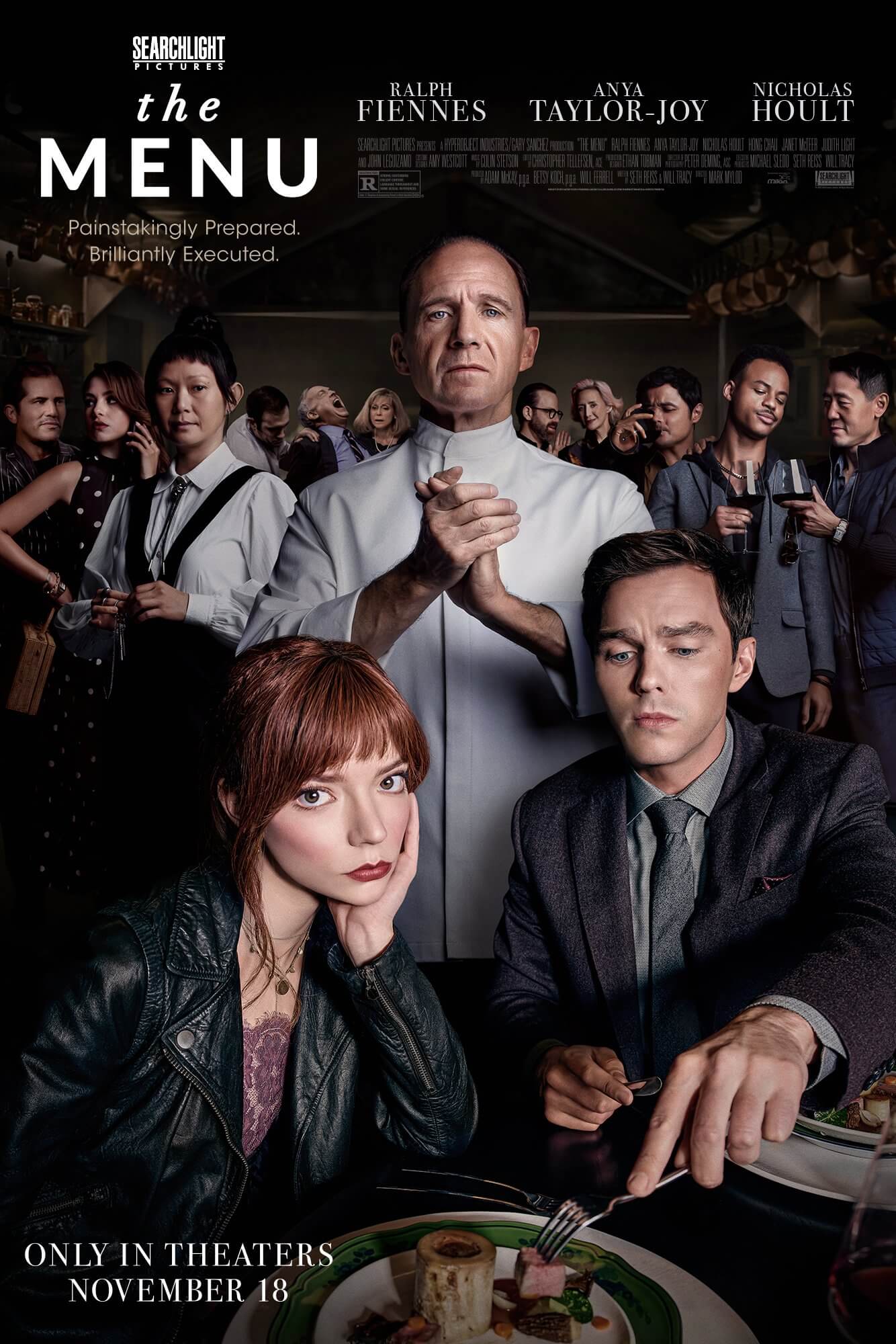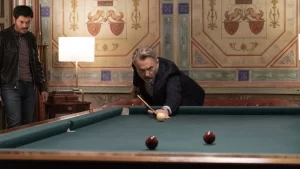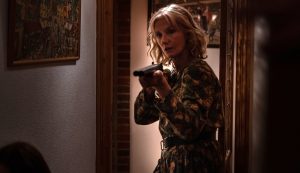The Menu, the new film from director Mark Mylod, is a whip-smart black comedy wherein “A couple (Anya Taylor-Joy and Nicholas Hoult) travels to a coastal island to eat at an exclusive restaurant where the chef (Ralph Fiennes) has prepared a lavish menu, with some shocking surprises.” The cast is superb, with Taylor-Joy getting yet another standout role alongside familiar faces such as John Leguizamo and Judith Light, and while you might think the trailer has clued you in to what’s going to happen, you have no idea.
Part of the film’s tone is due in no small part to the music of Colin Stetson. The saxophonist and composer’s score sees Stetson tackling comedy for the first time in his career, and the result is nothing short of wonderful. Coming on the heels of such work as Texas Chainsaw Massacre, Color Out of Space, and Hereditary, it’s something new and exciting.
Ahead of Searchlight Pictures’ release of The Menu, we hopped on Zoom with Colin Stetson to discuss his work while both of us attempted to sidestep any potential spoilers.
STARBURST: Having watched The Menu, one can absolutely see why you wanted to do this. It fits with the kind of movies that you have been doing like lately – they’re a little weird or they’re a little off in terms of how you feel watching them – but this seems to be like the first that could be called a comedy that you’ve done.
Colin Stetson: Yes. It’s not because I wouldn’t want to – just because I’ve not been offered one that I’ve really loved. There are a couple of ’em that have floated around me, but I haven’t really been, super into the script, as you can see by the things that I ended up doing: The Menu, Hereditary, a couple years ago, I did a film for Karen Cinorre called Mayday. When I’m reading something. I like the feeling of having not read it before, you know?
This is something I haven’t seen done a million times in different ways and this is a film that I’d never seen before, and so I was immediately excited by it because of that. But then also it really just reads exactly like it comes across on screen. It was very tight. It practically wrote the music for itself. It’s all right there. You know exactly where everything’s going to change – when I get to let certain cats out of bags and whatnot. It’s all there and it’s all very very neat and tidy.
In your time as touring musician, one has to imagine you’ve come across some interesting restaurants. A lot of what makes this film so fun is if you’ve watched any sort of cooking show, you get an idea of what sort of highfalutin concepts are on display. Have you ever been to some odd restaurants from which you could draw experience for this score?
Oh, for sure. I don’t think I’ve ever been to one where with so much of a performative aspect. I mean, it is a movie, but I certainly have been to my share of fancy places, so one of the things that I wanted to make sure to do is to lean into all this pomp and delight and lavishness and pretentiousness that’s built into it. Those spaces can be and are very over the top, in that regard. High-minded, but at the same time, it is beautiful.
There are scenes in the film where Chef is talking about the food, and talking about the approach, and talking about and I do think that it fundamentally is very profound – the experience of it, the alchemy of it, the arch of it all. Those two things exist simultaneously – if not in conflict, then in harmony. I tried to do that with the film, with the music: to have it both ways, to a certain extent and to really play very emotionally and very truthfully and to be able to acknowledge that the profound and the artistic and the experiential and at the same time have a “nudge, nudge, wink, wink” look at it from the other end, as well.
I think a lot of the music does it’s a constant push and pull. Some of the cues are very, very much leaning into taking the piss out of itself and then, other ones are just very emotionally present and sincere.
To that end, the track which specifically comes to mind in terms of being very emotionally sincere is “The First Cheeseburger You Ever Ate.”
Ooh, yeah. That scene is – to not give anything away – it is shot so lovingly, you can feel the heart.
Anyone who has seen this movie comes away from that scene saying, “I can taste it,” and that’s what makes it work: you’re scoring this not in a mocking way. It is as loving as the attention Chef is giving what he is cooking.
Oh, absolutely. In establishing a score in the very beginning, in the first act, I would reference something like “Nature is Timeless” off of the score for the scene where Chef is introducing the night and really just going fully into the experiential and the artistic and then naturalistic. I wanted to really milk the beauty of that and the sincerity of his devotion. There’s a specific approach with him that, that is quite churchy. There is a real sincere and devotional aspect to a lot of that, and dreamy because also, this is not just any night that he’s describing. all this. This is the moment.
What is established there threads through several moments throughout the whole of the score and ultimately comes to fruition in that last volley of scenes. But, yes: with “Cheeseburger,” the choir is there, and I used bowed piano strings, but the effect is very harpsichord-ish, so there’s a lot of an early baroque sincerity and devotional aspect to that maybe more so than anywhere else, but then using that, juxtaposing that with all of the other pillars that there are in the score.
The majority of the DNA, like the gut bacteria DNA of this whole score, is the pizzicato – that driving polyrhythmic kind of very mathy pizzicato that starts with the orchestra strings and then, as soon as the Act Two incitement moment happens, the aesthetic and the colours change because I introduce the plucked piano strings and then it gets very agitated, but that same polyrhythmic, mathy, overlaid driving rhythmic thing remains. That, to me, is really what is the essence or the skeleton – the thing that holds the whole thing together. I get to play the other aspects against one another throughout.
The film starts off rather languidly – “We’re going to dinner!” – and it just gradually increases as it goes along until it hits, as you said, at that point, wherein it takes off running. While there’s constantly tension present in the film, it really shoots up in terms of speed and action. How do you like lay that groundwork without tipping your hat too much?
For me, it was making like everything’s there. Well, not quite everything is there, but the rhythmic aspect of it and that drive is all presented in this very delightful, innocuous, playful way in the beginning. But all those rhythms are still there and they’re still leading to a point, so presenting them in a way which is – I wouldn’t say veiled, but it really is leaning into major keys, plucked violins, and violas and cellos in a way that manifests as being very delightful and excited for something extravagant and just leaning into all of that.
When that moment happens – I mean, I was reading the script and went, “Oh, okay. I, I mean, I know exactly how that moment goes, and it’s really that, the whole time the movie is going there is. It’s like at the old Coliseum – there’s a dark little portcullis with bars in front of it. You know there’s something back there. I figured there, I had a beast at bay that I would fully let out, and not in increments, but once that moment happens, it springs into life and so, I get to completely change or introduce something entirely different.
Then, the fact of that then being present with everything, it’s like an oil slick on water: it changes the overall aesthetic and colour and appearance of everything else that had occupied and populated the score before. The pizzicato is still there, but it’s played a little bit more aggressively and it’s mixed much more aggressively. The pizzicato then starts to have a lot of piano plucked very aggressively in it.
I also used a traditional instrument from Scandinavia called the nyckelharpa. How would I describe those strings? There are a lot of very emotive aggressive – almost growling – strings and then these chugging strings. That’s all me playing that instrument. It gets to have this complete moment of incitement that, where the whole of it is made a plurality. to it then.
What was fun was that in the very beginning, the first act, like you said, things happen very gradually. I can kind of nod to this and wink to this and, make little tweaks to kind of say, “Is it?” or “Are we?” but I can’t let anything out. As soon as everything is out, then not only do I have all of that material that goes into every extreme but then, I also have all of that delightful plucky pomp in the beginning that now – because we know where we’re at – we assume we know what we’re doing and what is happening.
All that stuff, to me, becomes quite funny, especially in the context of the horror. Then I get to use that in a way where sometimes, it’s in the midst of, of everything else and other times, it’s a juxtaposition of everything else, and that’s how I wanted to tie the whole thing together – to play to much of the comedy that happens throughout the end part. It is very, very tense, as you know, and there are moments which are quite aggressively so, but it’s still a very fun and very cheeky movie, so it still had to have that self knowledge.
The Menu is out Friday, November 18th, from Searchlight Pictures, as is Colin Stetson’s score via Milan Records.






